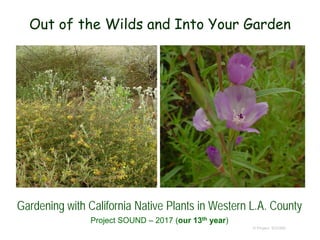The document discusses methods for attracting dragonflies to gardens in western L.A. County, highlighting the importance of understanding local dragonfly species and their habitat needs. It details the various types of dragonflies and damselflies, their characteristics, and their roles in ecosystems, including their predation on pests like mosquitoes. Additionally, it emphasizes the need to create suitable habitats, such as ponds, to support dragonfly populations, which are declining due to urbanization.

































































![Rooted emergent plants: CA natives
Arrowhead (Sagittaria spp.)
Bog Bean (Menyanthes trifoliata)
Bog Cress (Rorippa palustris)
Cattail (Typha spp.)
Horsetail (Equisetum spp.)
Indian Rhubarb (Darmera peltata)
Common Mare's Tail (Hippuris
vulgaris)
Marsh Marigold (Caltha leptosepala)
Pondweed (Potamogeton natans;
Potamogeton nodosus; Potamogeton
pusillus)
Water Bulrush/Tule (Schoenoplectus
[Scirpus] spp.)
Watercress (Nasturtium officinale
[Rorippa nasturtium-aquaticum])
Water Clover (Marsilea species)
Watershield (Brasenia schreberi) –
Sierra & N. CA native
Waterpepper (Persicaria
hydropiperoides [Polygonum
hydropiperoides])
© Project SOUND](https://image.slidesharecdn.com/dragonflies-2017-170702134211/85/Dragonflies-2017-66-320.jpg)





































































